Which Popular Funds Will Hit Investors With Losses and Capital Gains Distributions This Year?
Some Vanguard, Fidelity, T. Rowe Price, and other mutual funds estimate big distributions despite big losses.

Get ready for capital gains distribution season, mutual fund investors. It’s that time when fund companies try to give their investors an idea of what their 2022 tax bills may look like by estimating how much their funds will distribute in income and capital gains later in the year.
The Morningstar US Market Index’s 18.8% decline this year through Oct. 31 should provide fund managers plenty of opportunities to harvest some losses to offset potential gains. There still will be distributions, though. Many funds entered this year holding appreciated assets from a strong 2021 and the long bull market before 2020. Because of selloff-triggered outflows and the ongoing trend of investors swapping actively managed stock funds for passive exchange-traded funds, many managers have had to realize some of those gains to meet redemptions. Funds must pass those long- and short-term proceeds to shareholders, who, if they own their funds in taxable accounts, must pay taxes. That means funds that have suffered steep falls this year could still distribute capital gains to investors, such as Vanguard Global Equity VHGEX (see rest of Vanguard’s capital gains distribution estimates at the end of the following alphabetical list of fund families).
Fund families are still releasing their estimates, which they can still revise, but a preliminary look shows that many strategies in the value and blend Morningstar Categories will make sizable distributions. Some growth strategies that enjoyed several years of solid returns before 2022′s bear market will also make some significant distributions.
Fund companies have begun publishing distribution estimates on their websites, and most will make the actual payouts between late November and the end of the year.
Here’s a survey of some larger fund families’ distribution estimates.
AllianceBernstein
Several value- and blend-oriented AB funds are on track to make sizable capital gains distributions, ranging from 6% to 12%. The firm will mostly make payments in early to mid-December.
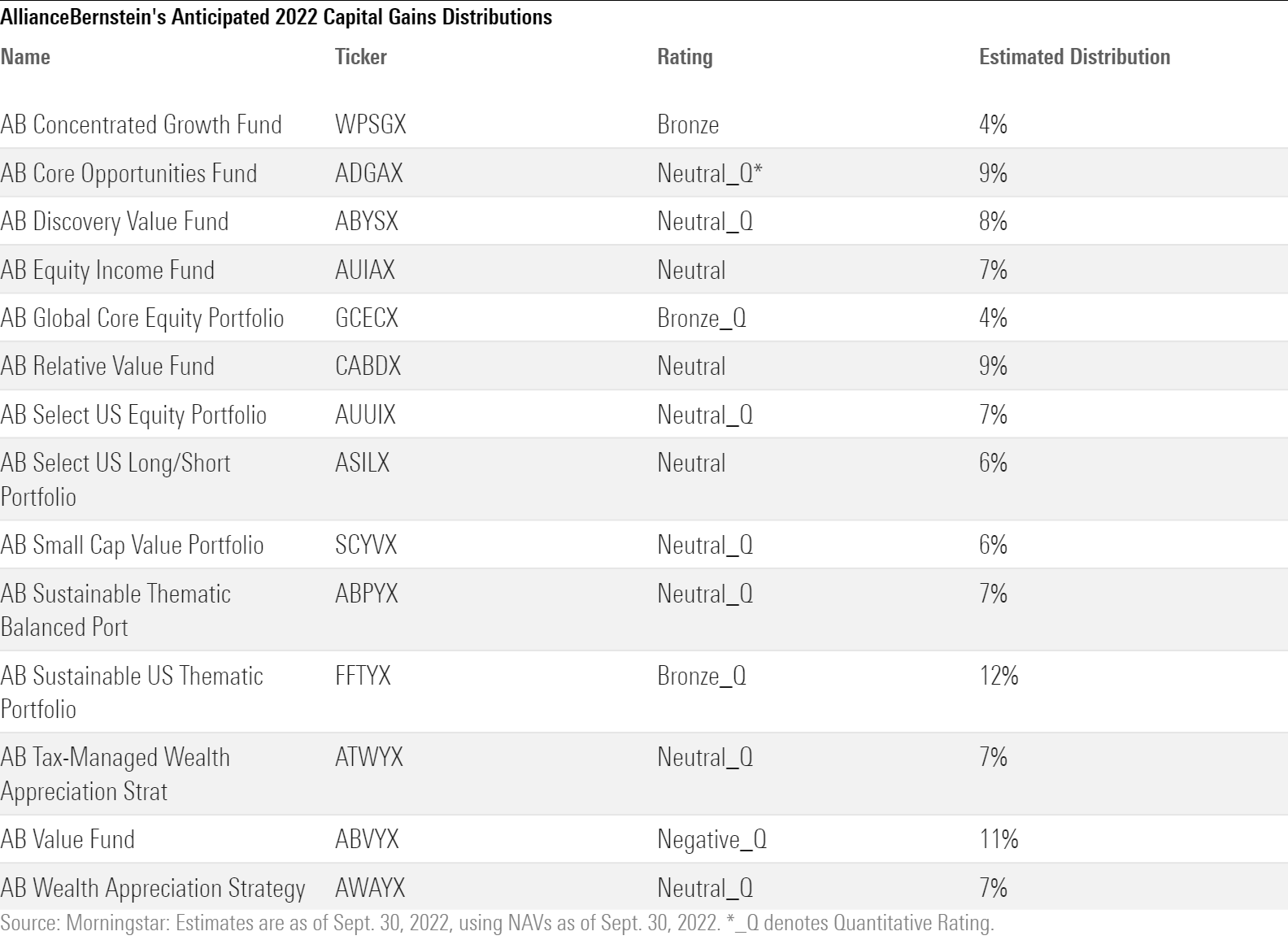
American Century
American Century’s funds will distribute less than they did last year, with a handful of value and three growth strategies making mid-single-digit to low-double-digit distributions. American Century Real Estate REACX will pay roughly 12.7%. Gains are mostly long term.
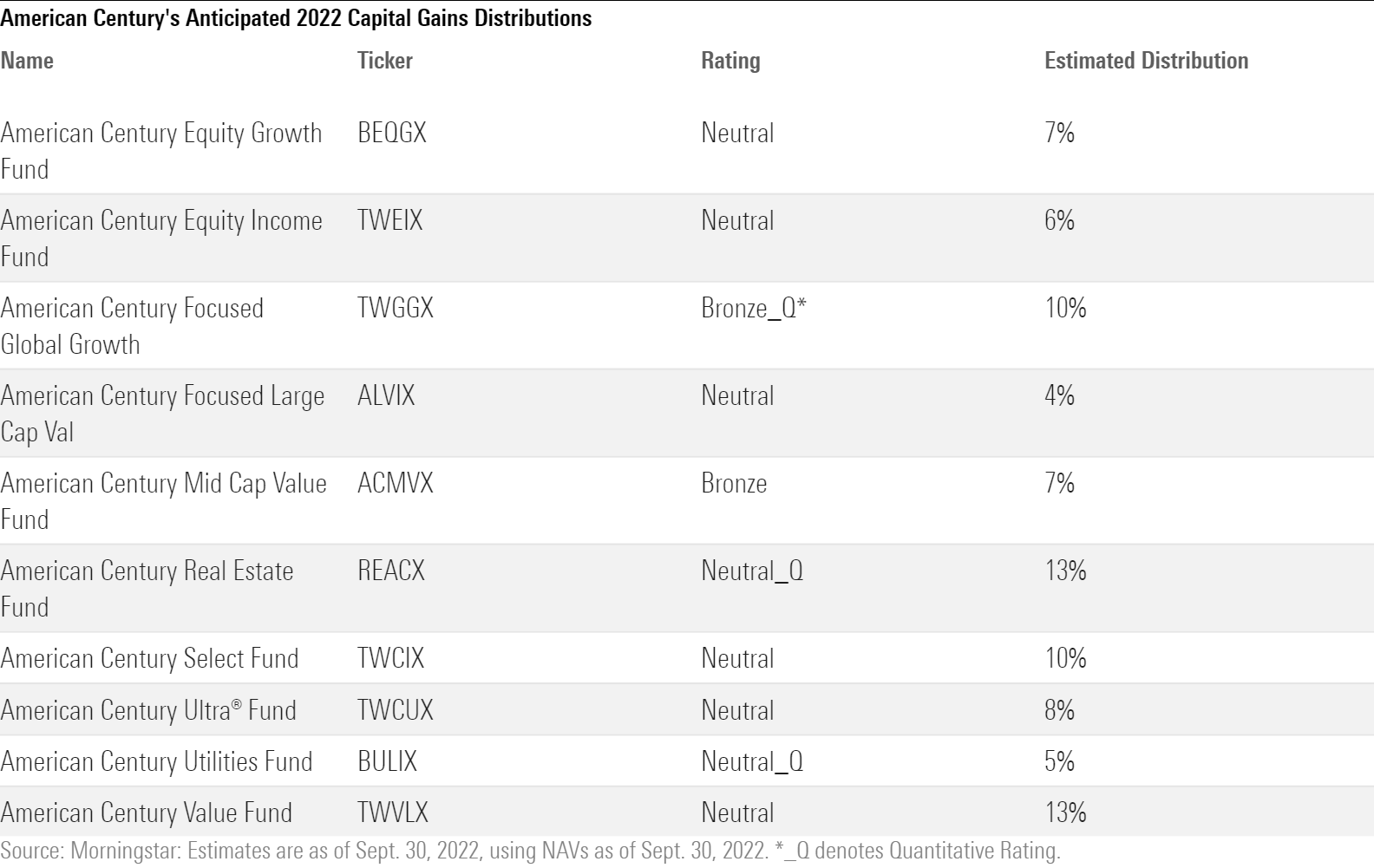
American Funds
Most American Funds also will pay out fewer capital gains in 2022 relative to their peer groups. The firm provides range estimates, and only American Funds American Mutual AMRMX and American Funds Income Fund of America AMECX come in at roughly 4.5%. All are long-term capital gains, though the actual amounts will be based on gains and losses realized through Oct. 31. A few model portfolios, American Funds Global Growth Portfolio PGGAX and American Funds Growth Portfolio GWPAX, will distribute roughly 7% and 8.5%, respectively.

AMG Funds
Several AMG funds expect to pay out big distributions. Two of the firm’s Yacktman funds, one of which has a Morningstar Analyst Rating of Silver, are on track as of September’s month-end net asset values to pay mid-single-digit to low-double-digit distributions. Bronze-rated AMG River Road Dividend All Cap Value ARDEX will likely pay a low-double-digit distribution. AMG will make payments on Dec. 15.

Ariel
Like last year, only Ariel’s U.S. strategies will make capital gains distributions in 2022, and they will mostly be long-term. The value boutique will pay its distributions, ranging from 7% to 11%, in late November.

BlackRock
Most of BlackRock’s actively managed strategies will have muted distributions this December, with only BlackRock Tactical Opportunities PCBAX estimating a distribution of more than 5%. The firm will make payments in December.

Columbia Threadneedle
A handful of Columbia Threadneedle’s value-oriented strategies expect to make moderate 2022 payouts. Columbia Seligman Technology & Information SLMCX and Columbia Seligman Global Technology SHGTX will both make 8% to 10.5% distributions. Columbia Integrated Large Cap Growth Fund ILGFX will make a roughly 40% capital gain distribution, thanks to sizable outflows.
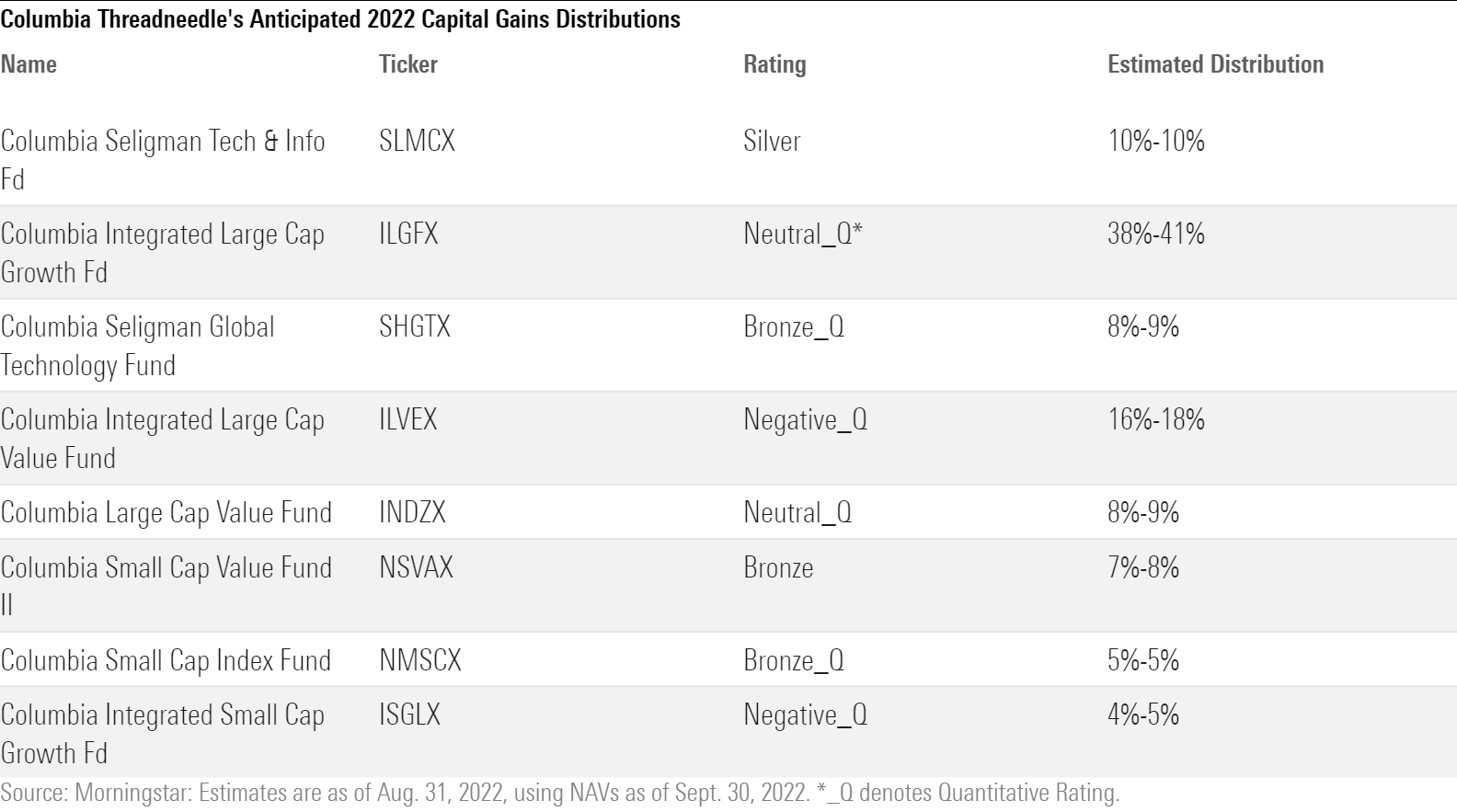
Delaware Funds
Several Delaware funds will make some of the biggest distributions, including a handful that likely will pay distributions of 30% or more. Delaware Sustainable Equity Income IDAIX will likely make a whopping 88% distribution because it changed its strategy. The firm has made its estimates based on Sept. 30 figures and will make payments in late November and late December.
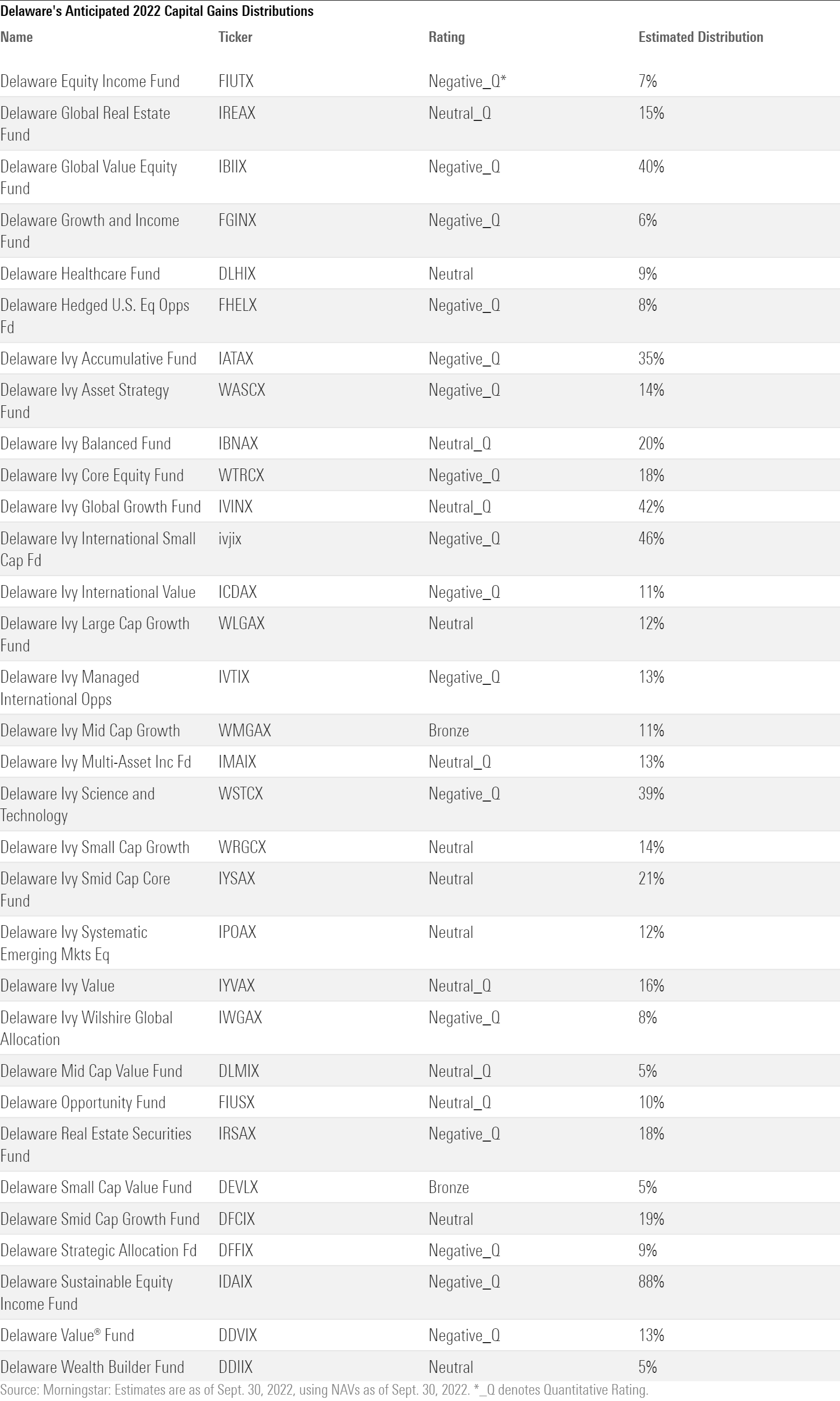
DFA
Dimensional Fund Advisors will pay out distributions in mid-December. Several funds are estimating payouts in the mid- to high-single-digit range, largely made up of long-term gains.
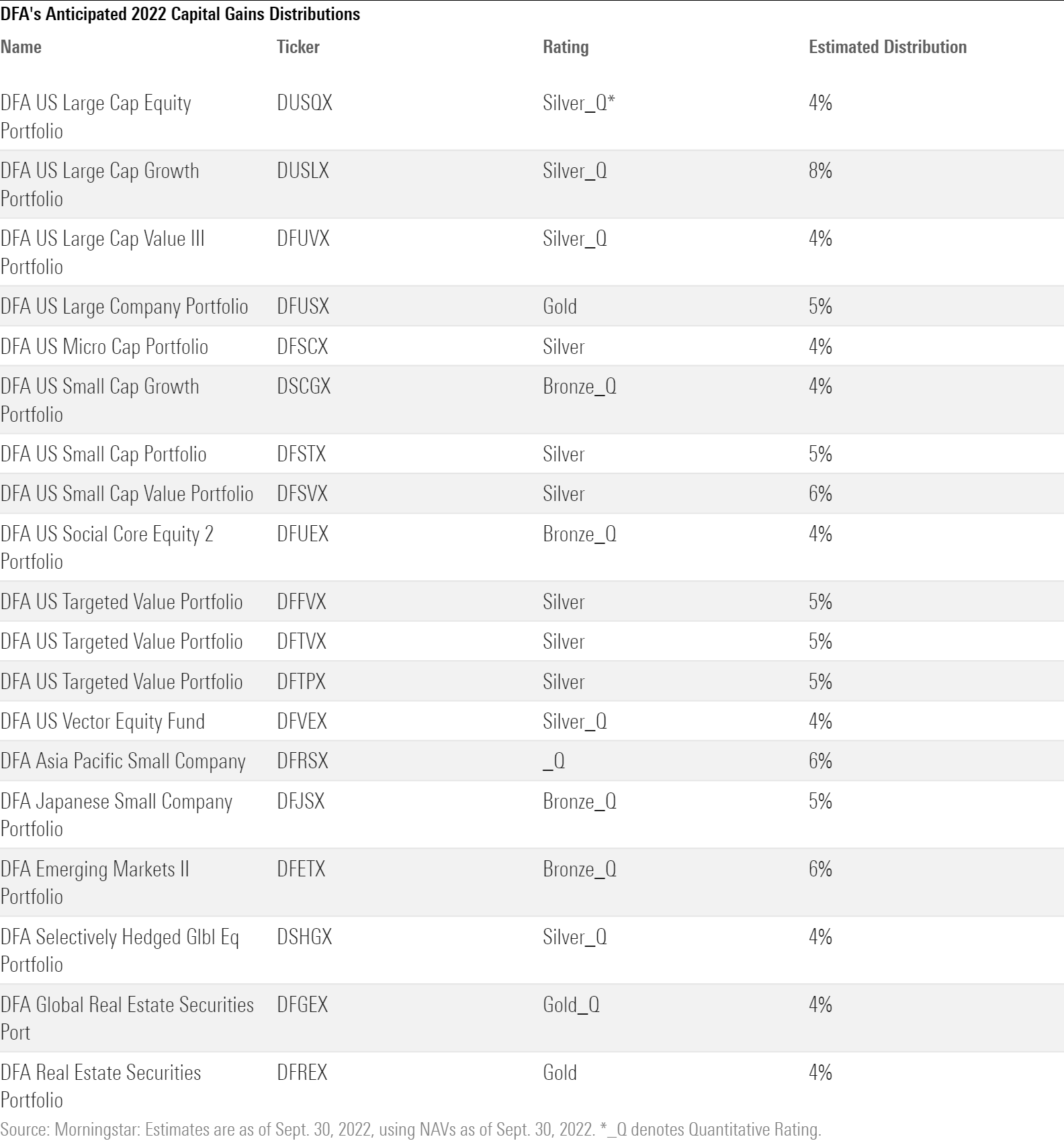
Fidelity
Many Fidelity funds expect to pay distributions of more than 5% of NAV in December. Growth- and value-leaning funds and a handful of sector funds will make most of the biggest gains. Fidelity Contrafund FCNTX, which has a Morningstar Analyst Rating of Silver, expects to pay out a roughly 8% distribution in mid-December. Fidelity SAI Real Estate FESIX, which has lost almost 50% of assets to outflows in 2022, will likely distribute 19%.

FPA
Only FPA U.S. Core Equity FPPFX will likely make a distribution larger than 5%.

Franklin Templeton
Several Franklin Templeton funds continue the family’s trend in recent years of making double-digit year-end distributions. The firm, which continues to suffer outflows, will make most of the payments in mid-December.
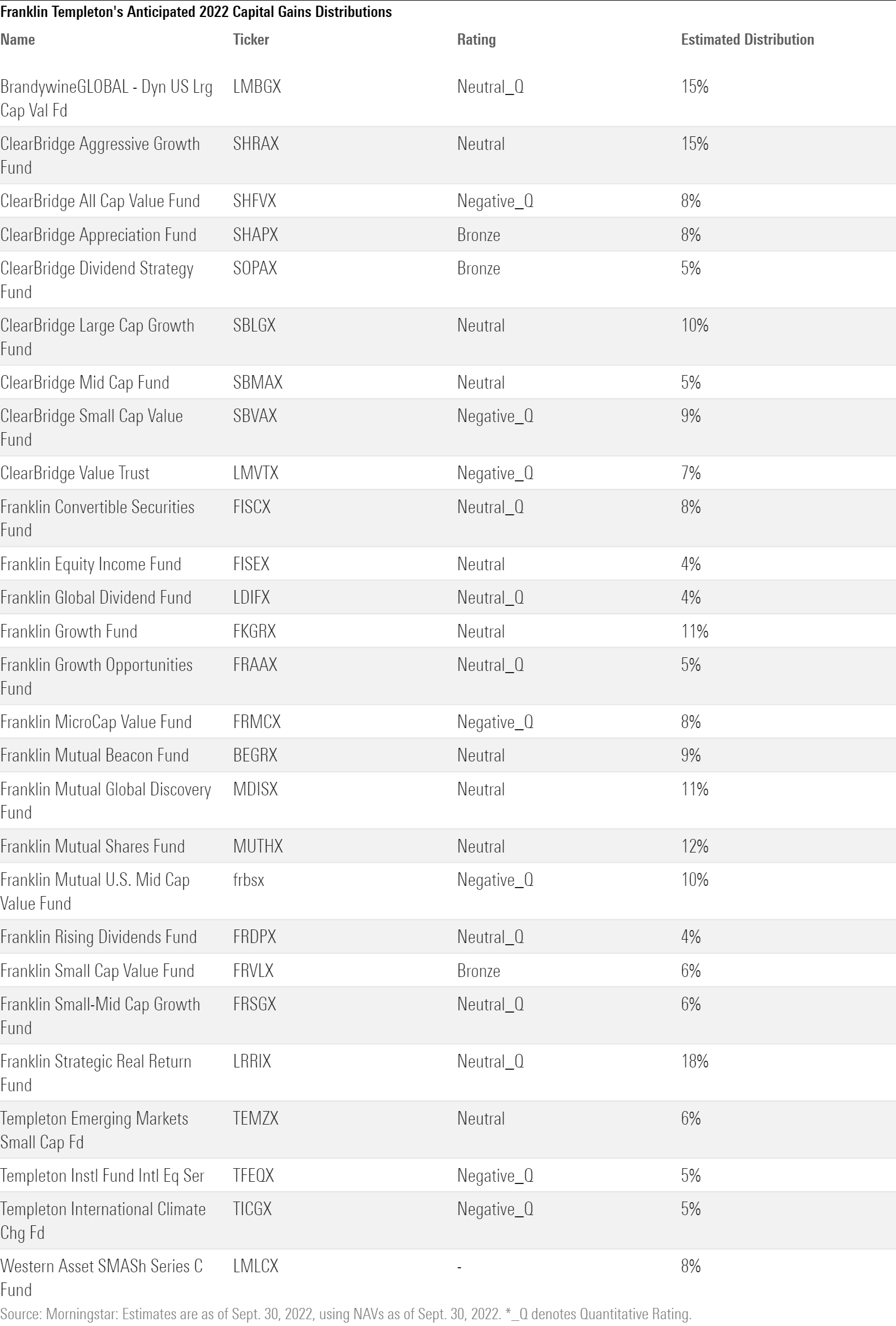
Harbor Funds
Only a few Harbor Funds’ strategies will make estimated distributions of 5% or more. Gold-rated Mid Cap Value HAMVX and Bronze-rated Small Cap Growth HASGX will both distribute 5% to 6% on Dec. 19. After roughly 20% outflows on the year through October, Harbor Global Leaders HGGAX will likely distribute 10%.

Invesco
Several Invesco funds will pay double-digit capital gains distributions in mid-December. Most, like Bronze-rated Invesco Comstock ACSTX, are value-oriented and some have been stung with heavy outflows over the trailing year ended Oct. 31, 2022. Some foreign strategies will also make sizable distributions with Invesco Global Growth AGGAX making roughly a 45% distribution.
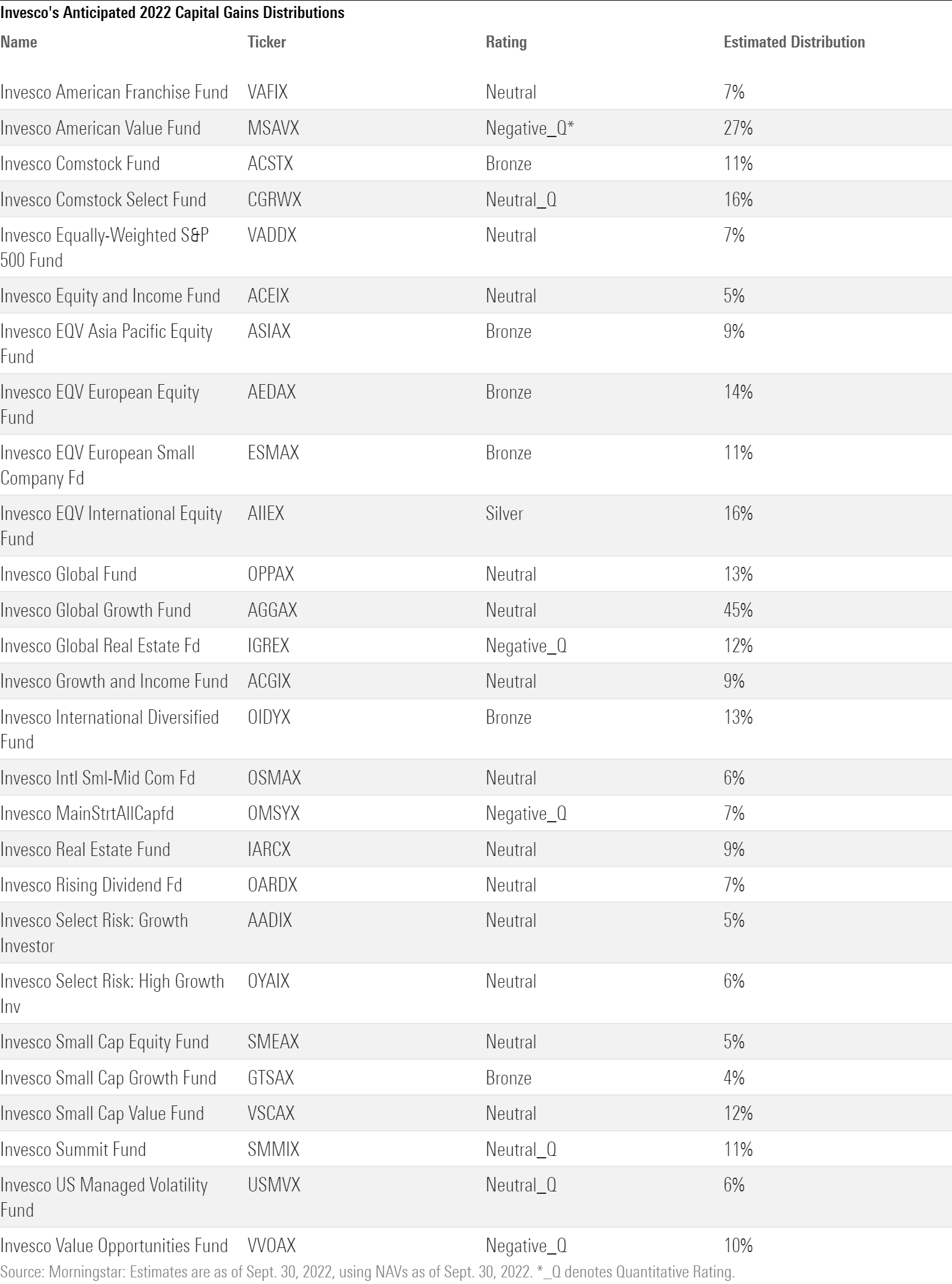
Janus Henderson
A handful of Janus Henderson funds will make 5% to 10% capital gains distributions in December. The firm has based its estimates on Sept. 1 figures and will make payments in late December.
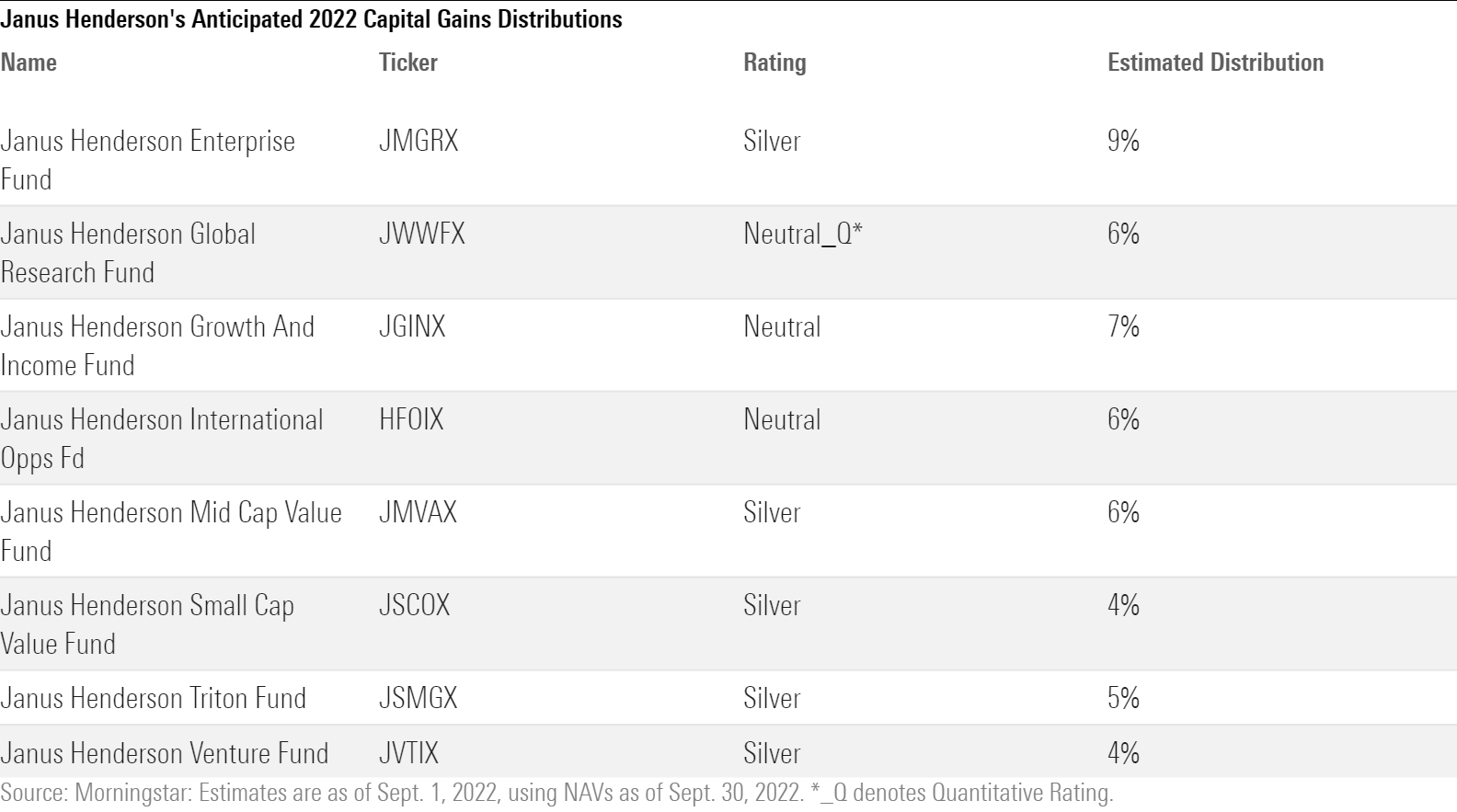
John Hancock
Several John Hancock funds will pay double-digit capital gains distributions in mid- to late-December. Most, like Bronze-rated John Hancock Equity Income JHEIX, are value-oriented, but there are a few blend- and growth-oriented strategies mixed in as well. Bronze-rated John Hancock Financial Industries FIDAX will also make a roughly 11% capital gain distribution.
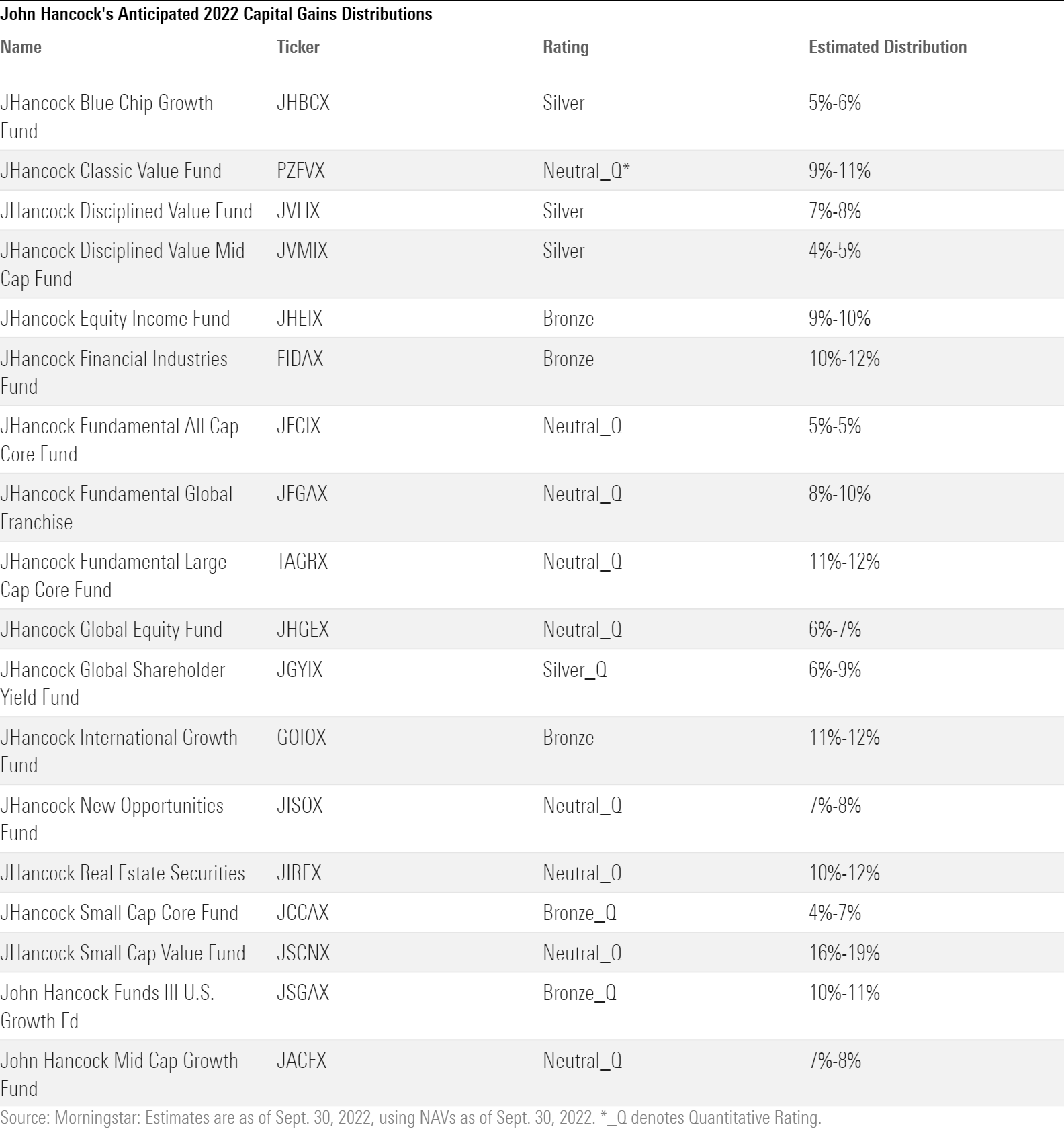
J.P. Morgan
A handful of value- and blend-oriented J.P. Morgan funds are on track to make high-single digit to low-double-digit capital gains distributions in December. Neutral-rated J.P. Morgan US Large Cap Core Plus JLCAX, which is a leveraged strategy, could make a roughly 24% distribution.
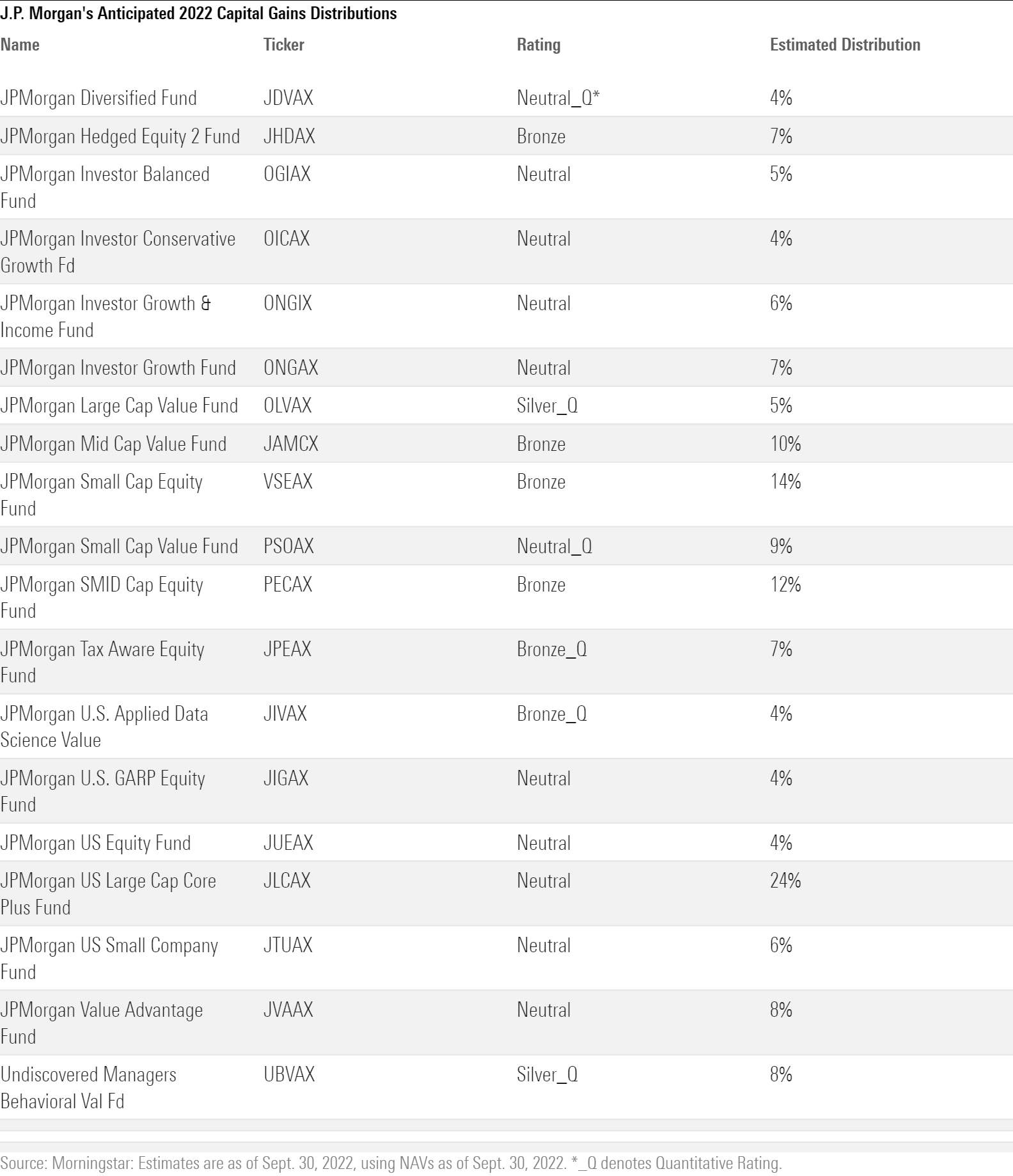
Lord Abbett
A few Lord Abbett Neutral-rated strategies will likely make 6% to 9% distributions in late December. Lord Abbett Value Opportunities LVOAX will likely distribute 12%. The firm has made its estimates based on July 31 figures and will make payments in late November and late December.
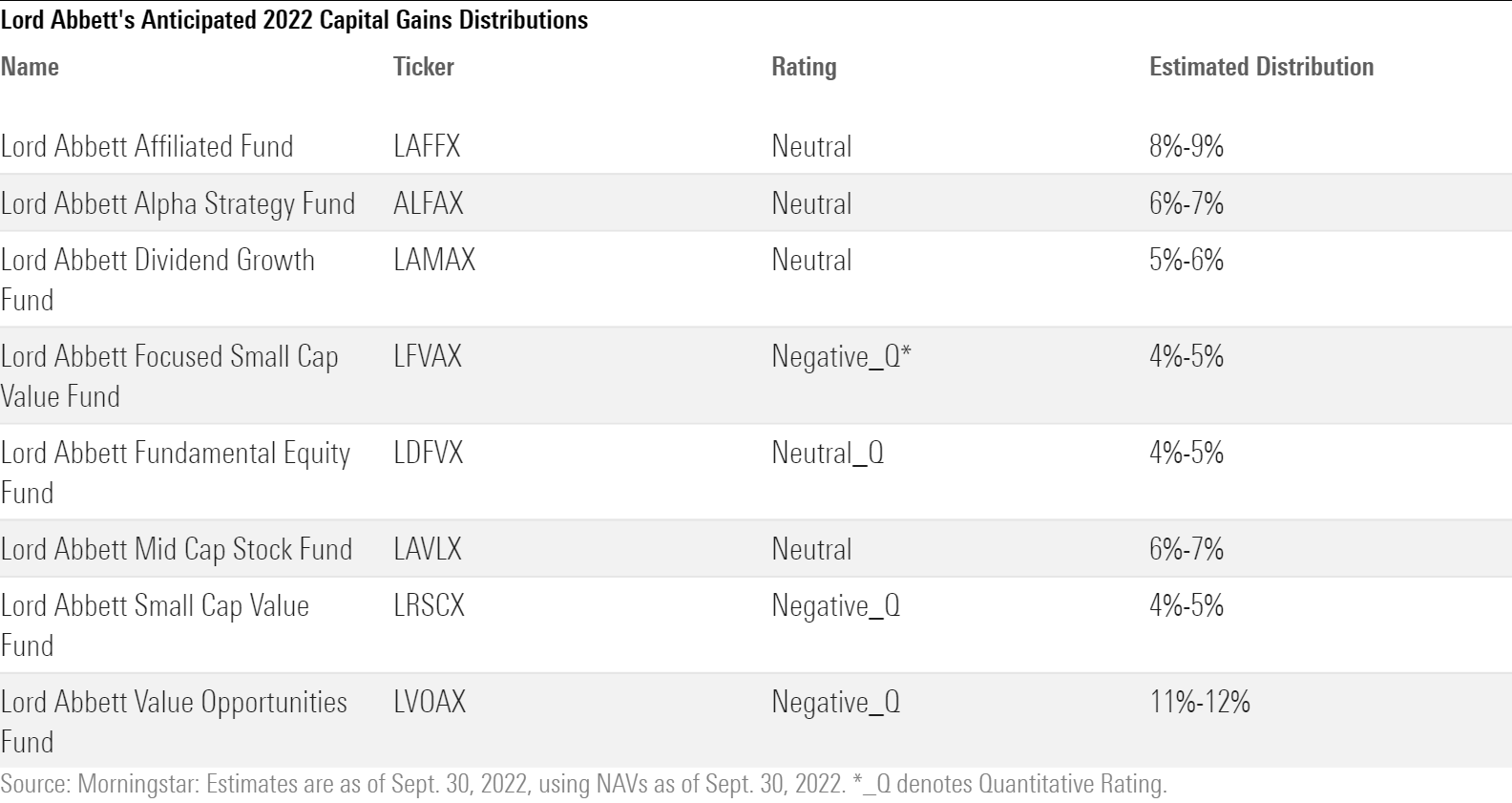
MFS
MFS’ Silver-rated global large-blend fund Global Equity MWEBX will likely make close to a double-digit distribution along with Bronze-rated MFS International Intrinsic Value MGIAX and MFS Technology MTCAX. The firm’s estimates as of Aug. 31 mostly comprise long-term capital gains.
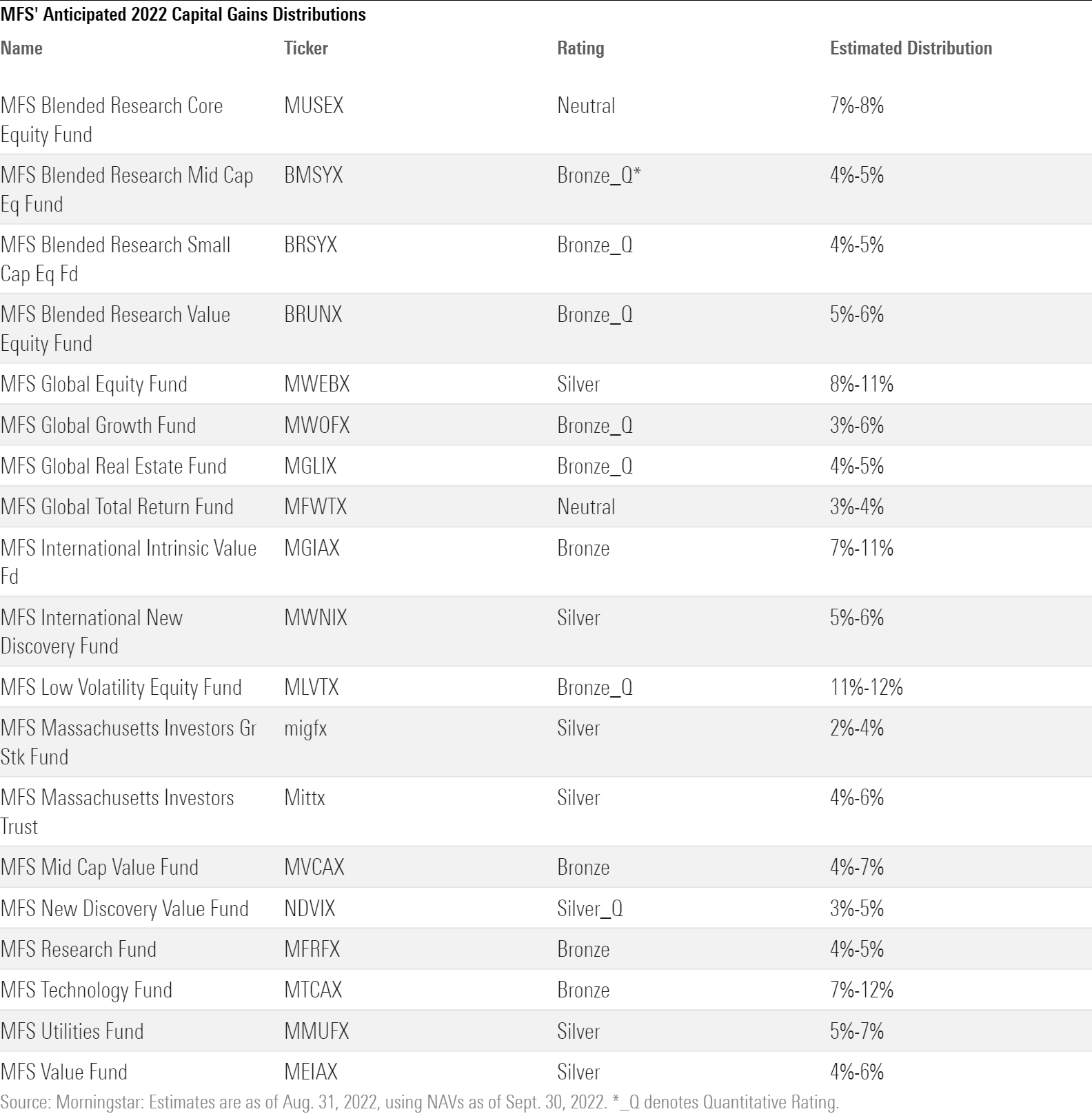
Nuveen
A handful of Nuveen blend- and value-oriented funds will make 5% to 10% capital gains distributions in December. Nuveen Real Estate Securities FREGX will likely make a 17% distribution. The firm has made its estimates based on Aug. 31 figures and will make payments in late December.

Oakmark
Only Silver-rated Oakmark Global OAKGX and Oakmark International Small Cap OAKEX will likely make capital gains distributions this December. Both are likely to distribute around 2%.

PGIM
A few PGIM Quant value- and blend-oriented strategies will likely make double-digit distributions in mid-December. Neutral-rated PGIM Jennison Global Equity Income AGOCX and PGIM Jennison Utility PRUAX will likely make high-single digit distributions. The firm has made its estimates based on Sept. 30 figures and will make payments in mid-December.
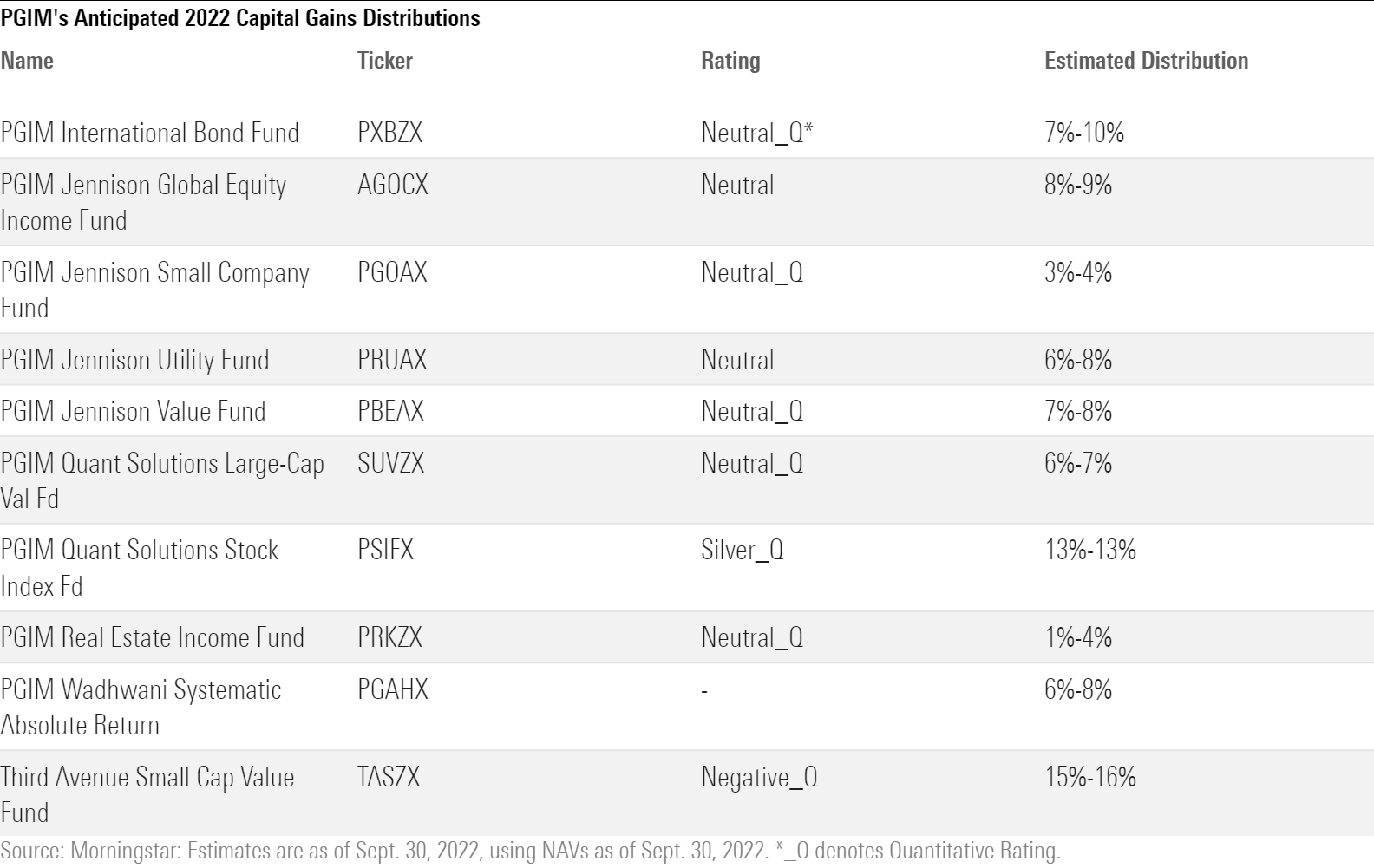
Primecap
While Primecap’s funds have bounced back relative to peers this year through September, all three Gold-rated strategies will distribute roughly 10% estimated capital gains payments on Dec. 15.

Principal
A few Principal value-oriented strategies will likely make double-digit distributions in mid-December like Principal Large Cap Value Fund III PLVIX and Primecap SmallCap Value II PPVIX. Silver-rated Principal LargeCap Growth I PLGIX will likely make a 12% distribution. The firm has made its estimates based on Sept. 30 figures and will make payments in late December.
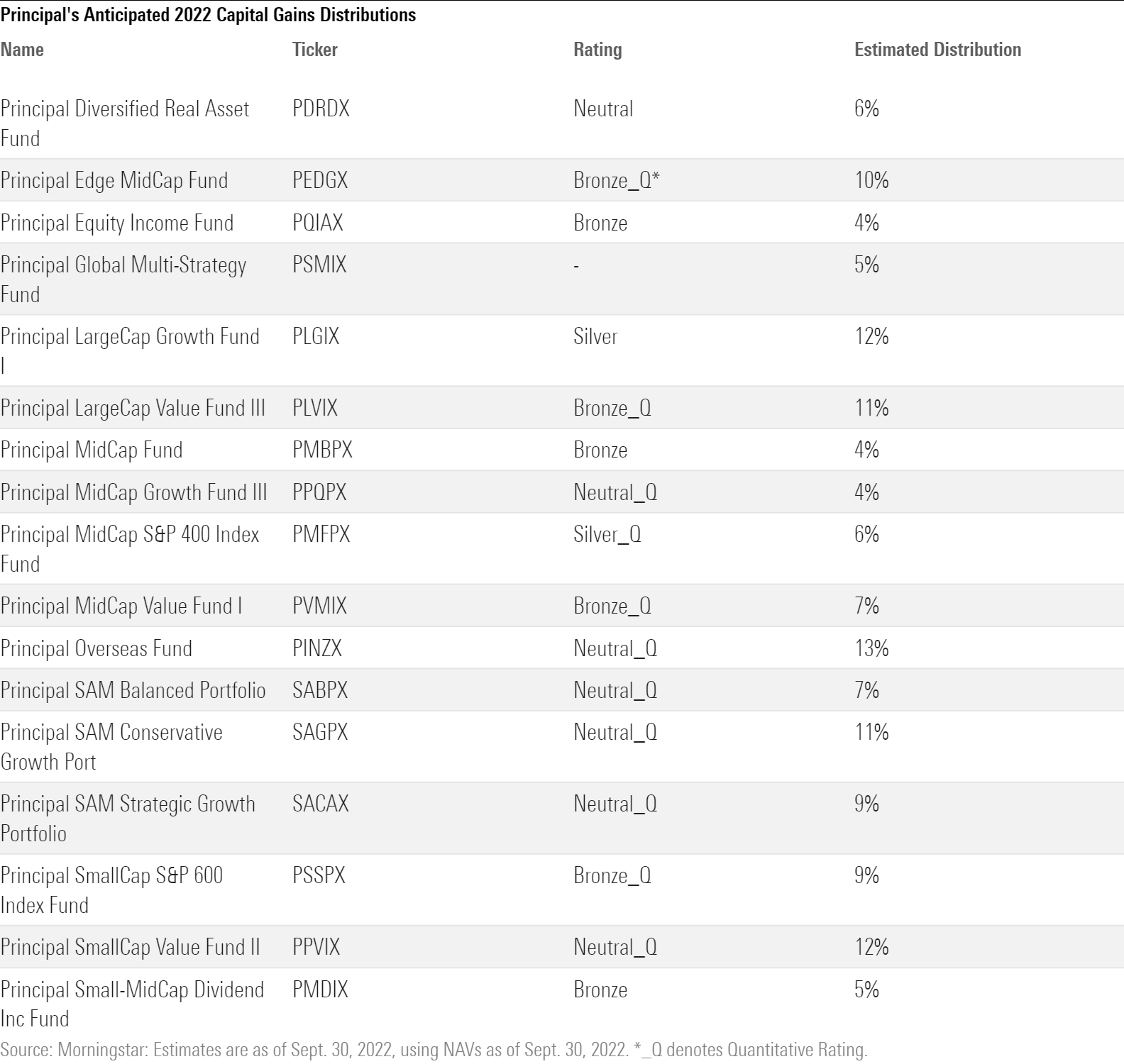
Royce
Two Bronze-rated Royce small-value strategies will likely make low-double-digit distributions in mid-December. Silver-rated small-growth Royce Premier RPFIX will likely distribute 10%. The firm has made its estimates based on Oct. 18 figures and will make payments on Dec. 15.
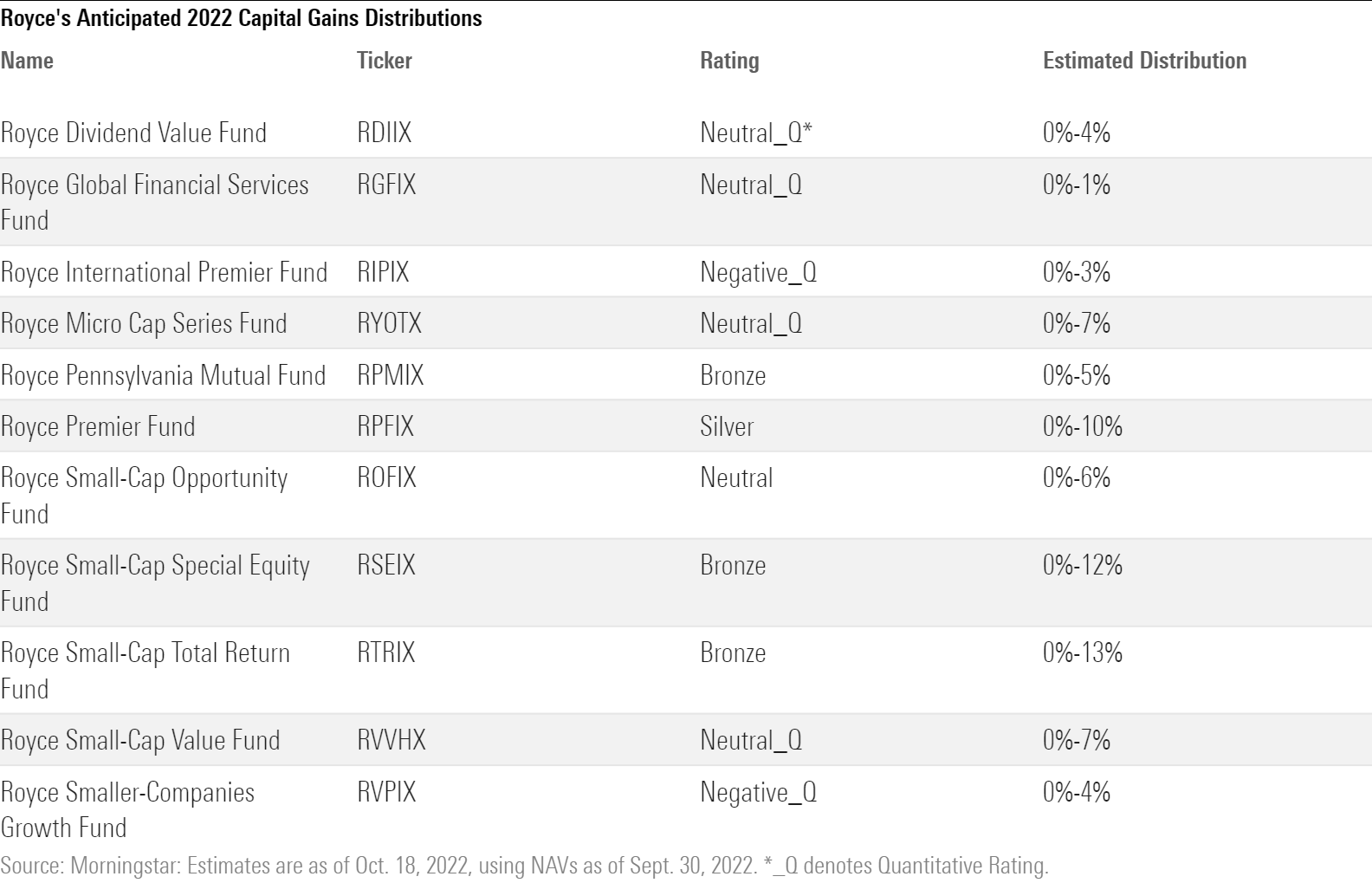
T. Rowe Price
Several T. Rowe Price funds will make meaningful distributions. While most funds are value- and blend-oriented strategies, such as T. Rowe Price Large Cap Value TRLUX and T. Rowe Price Mid-Cap Value TRMCX, a few sector funds, such as Gold-rated T. Rowe Price Communications & Technology PRMTX and T. Rowe Price Real Estate TRREX, will make big distributions. Global quantitative T. Rowe Price QM Global Equity TQGEX will likely distribute 19% after seeing roughly 28% in outflows through September.
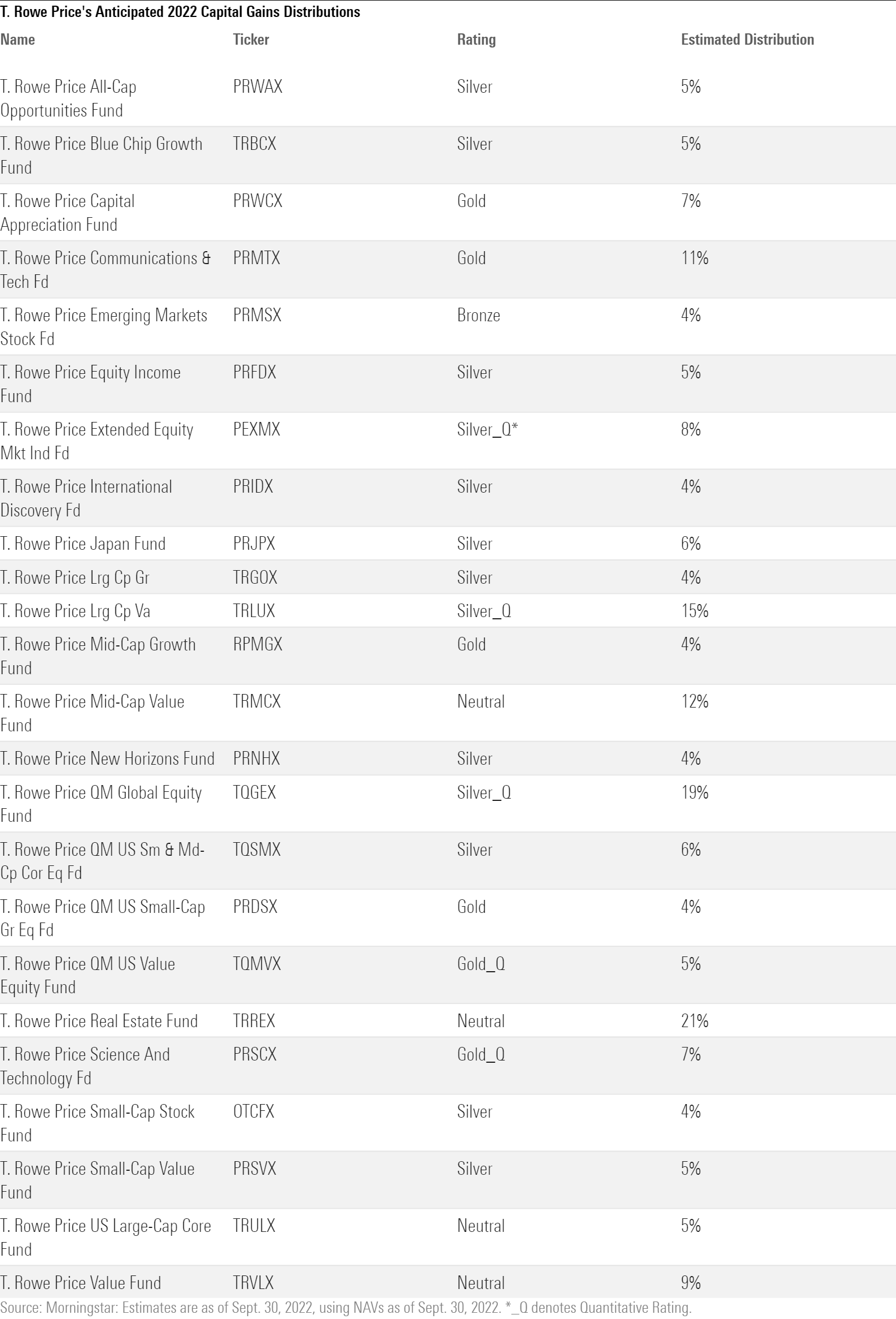
TIAA-CREF
Bronze-rated large-blend TIAA-CREF Growth & Income TIGRX will likely make a 9% capital gains distribution. Two other strategies will likely distribute high-single-digit to low-double-digit gains.
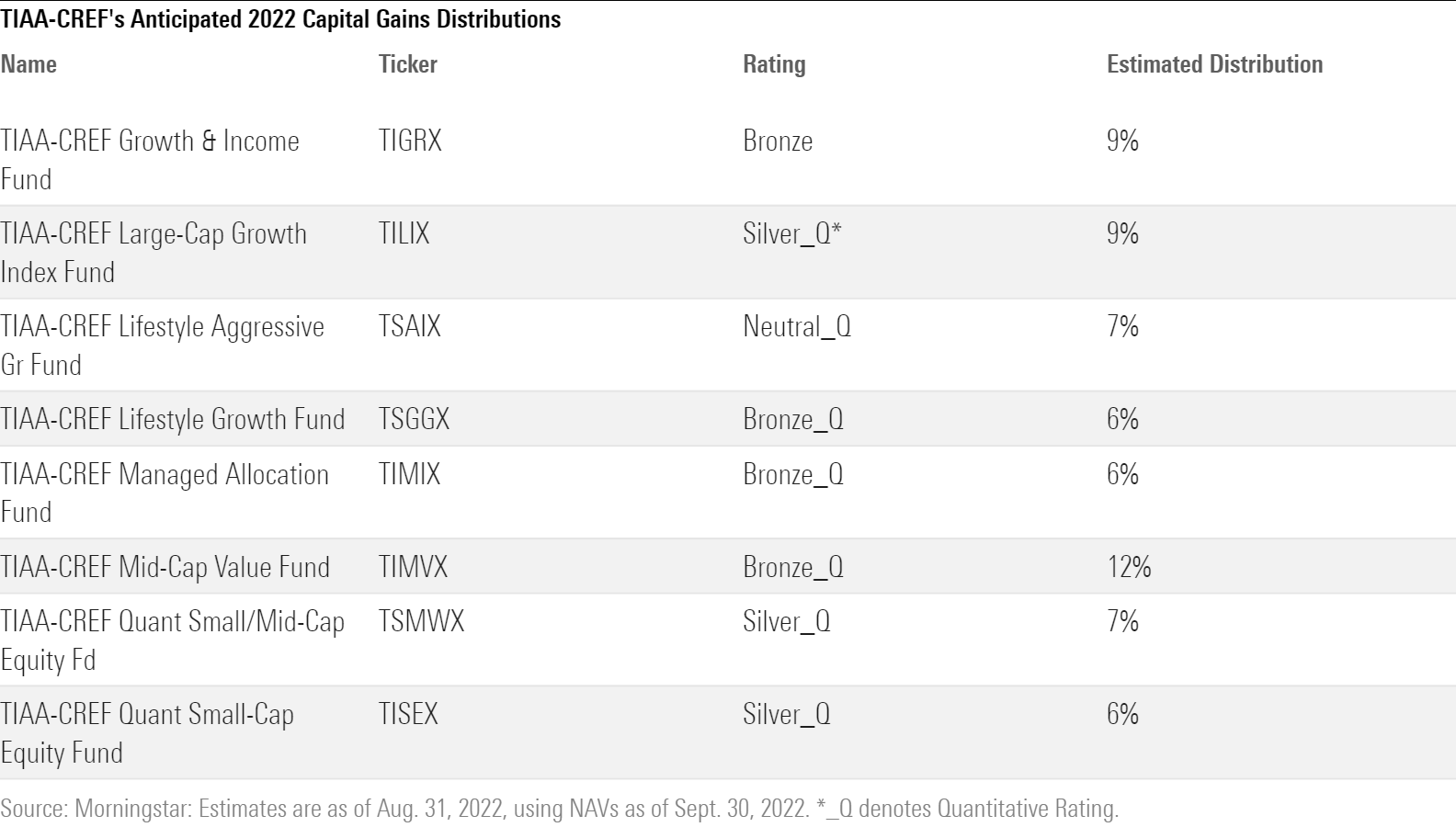
Vanguard
Several Vanguard actively managed funds will make meaningful distributions in December. Silver-rated, value-oriented Vanguard Windsor VWNEX will make the largest, with a roughly 14% distribution. Vanguard Selected Value VASVX and Vanguard Strategic Equity VSEQX, both Bronze-rated, will make low double-digit distributions. Some growth funds will also make decent distributions, such as Gold-rated Vanguard Capital Opportunity VHCAX, which will likely make an 8% distribution.
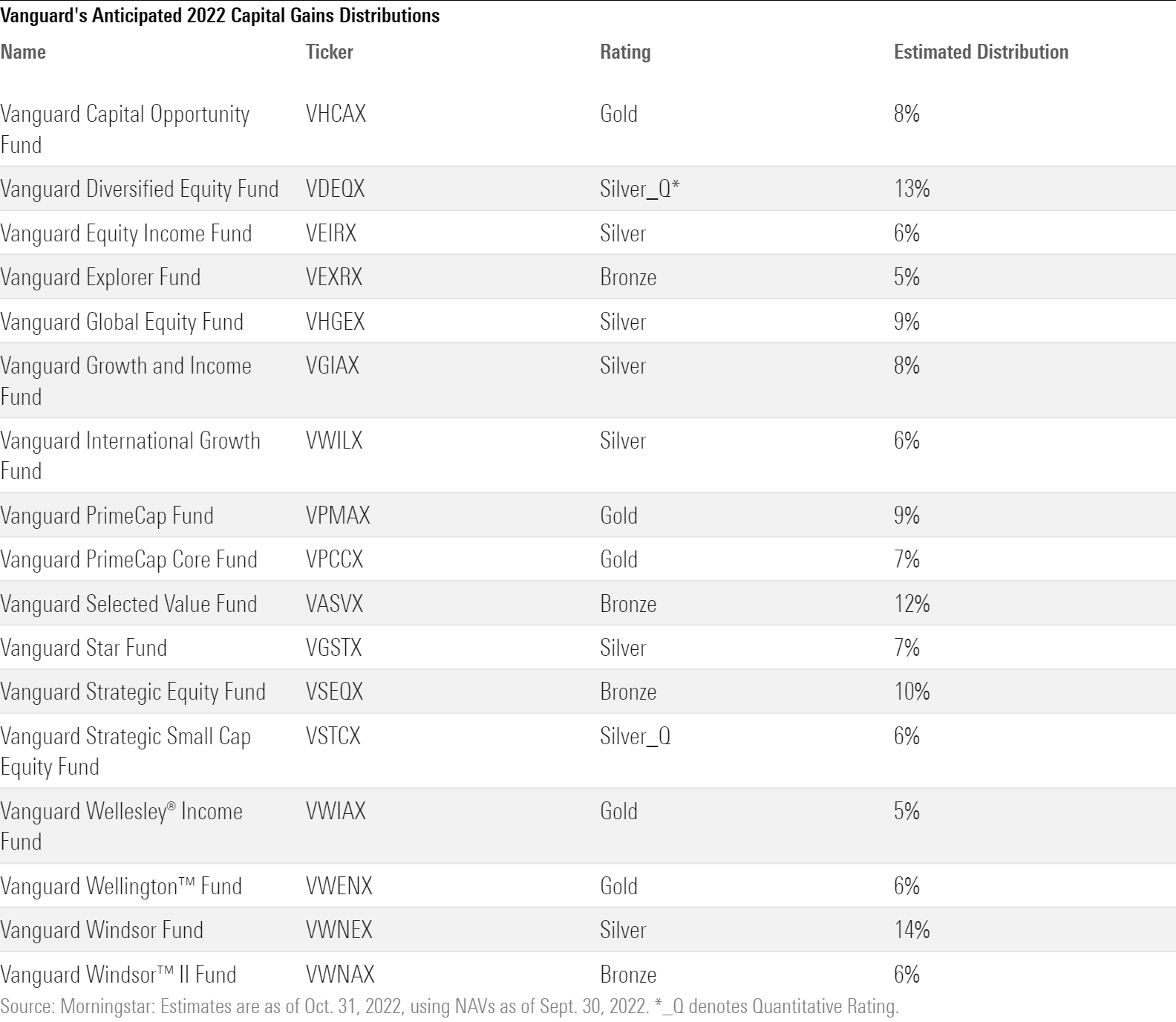
Virtus
Funds from across Virtus’ stable of boutiques will make sizable double-digit distributions in December. A few funds, like Silver-rated Virtus KAR Small-Cap Growth PXSGX, which is closed to new investors, will likely make a double-digit distribution after years of strong performance and outflows from existing shareholders.

Why You Should Pay Attention to Capital Gains Distribution Estimates
If you invest in a tax-sheltered account, such as a 401(k) or an IRA, and you’re reinvesting your distributions, distribution previews seem like a nonevent because you won’t owe taxes until you sell your holdings in retirement and maybe not at all if you invest in a Roth IRA.
There are good reasons to pay attention to them, though. Investors with taxable accounts owe taxes on distributed gains even if they reinvested them, unless they’ve sold losing positions to offset the gains.
Reinvested capital gains help increase your cost basis, which could reduce the capital gains taxes you owe when you eventually sell the fund. So, if you hold a serial capital-gains-distributing fund, selling it in the future may cost less than you anticipated, owing to all the cost-basis step-ups that the regular distributions triggered.
Taxable investors considering buying a fund that has predicted it will make a distribution also may consider delaying the purchase until after the payout to avoid getting distributions without the benefit of any gains.
Tax considerations, of course, are just one of many factors in an investment decision. Check with a tax advisor before trading.
This article was previously published on Nov. 2, 2022, and is updated when new information is released.
Correction: The original Vanguard table had two repeated entries. It has been fixed.
The author or authors own shares in one or more securities mentioned in this article. Find out about Morningstar’s editorial policies.

/s3.amazonaws.com/arc-authors/morningstar/c52d2eba-3a3c-478f-b3bd-c3ca80a5100f.jpg)
:quality(80)/cloudfront-us-east-1.images.arcpublishing.com/morningstar/OMVK3XQEVFDRHGPHSQPIBDENQE.jpg)
:quality(80)/cloudfront-us-east-1.images.arcpublishing.com/morningstar/WJS7WXEWB5GVXMAD4CEAM5FE4A.png)
:quality(80)/cloudfront-us-east-1.images.arcpublishing.com/morningstar/NOBU6DPVYRBQPCDFK3WJ45RH3Q.png)